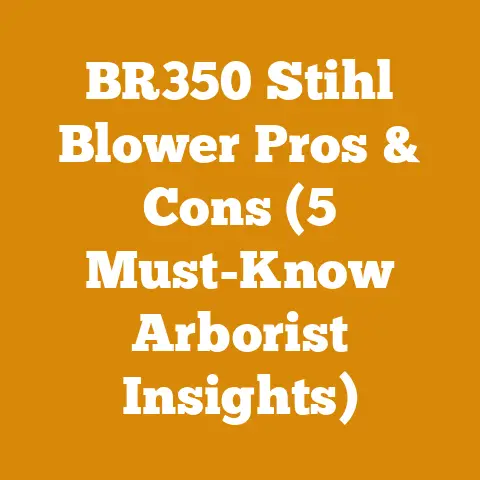Portage & Main Outdoor Wood Boiler (5 Expert Tips to Max Efficiency)
Addressing climate-specific needs is crucial when maximizing the efficiency of your Portage & Main outdoor wood boiler. I’ve spent years working with wood boilers in various climates, from the frigid winters of northern Minnesota to the milder, but still demanding, conditions of the Pacific Northwest. The strategies that work in one region might not be optimal in another. That’s why I’ve tailored these expert tips to be adaptable, focusing on the core principles that can be adjusted to suit your specific environment. Let’s dive in.
Portage & Main Outdoor Wood Boiler: 5 Expert Tips to Max Efficiency
My journey with wood boilers began out of necessity. Living off-grid, I needed a reliable and cost-effective way to heat my home and shop. After trying several different systems, I landed on a Portage & Main, drawn to their reputation for durability and efficiency. But even with a top-of-the-line boiler, I quickly learned that optimal performance requires more than just buying the right equipment. It demands a deep understanding of wood, combustion, and heat transfer. These five tips are born from years of trial and error, tweaked and refined through hands-on experience.
1. Master the Art of Wood Selection and Seasoning
The single most impactful factor affecting your Portage & Main’s efficiency is the quality of your wood. I cannot stress this enough. Wet wood is the enemy of efficient combustion. It steals energy as it evaporates the moisture, leaving you with less heat and more creosote.
- Species Matters: Hardwoods like oak, maple, and beech are your best bet. They pack more energy per volume than softwoods like pine or fir. A cord of seasoned oak, for example, will provide significantly more heat than a cord of seasoned pine. I’ve found that a mix of hardwoods is ideal, providing a consistent and long-lasting burn.
- The Seasoning Process: Aim for a moisture content of 20% or less. This requires splitting your wood and stacking it properly for at least six months, preferably a year. I use a moisture meter to check the wood before loading it into the boiler. It’s a small investment that pays dividends in efficiency and reduced maintenance.
- Stacking for Success: Proper stacking is crucial for air circulation. Stack your wood in rows, leaving space between each row and between the wood and the ground. Cover the top of the stack to protect it from rain and snow, but leave the sides open for ventilation. I use pallets as a base to keep the wood off the ground and prevent rot.
- Climate Considerations: In humid climates, seasoning can take longer. You might need to consider building a wood shed with good ventilation to accelerate the drying process. In drier climates, the wood can dry more quickly, but you need to be careful not to over-dry it, as this can lead to faster burning and less efficient heat transfer.
- My Experience: I once made the mistake of burning wood that I thought was seasoned, but hadn’t checked with a moisture meter. The difference in heat output was staggering, and I ended up spending significantly more time refilling the boiler. Lesson learned: always measure before you burn.
Takeaway: Choose hardwoods, season them properly to a moisture content of 20% or less, and stack them for optimal air circulation.
2. Optimize Your Combustion Airflow
Your Portage & Main needs the right amount of air to burn efficiently. Too little air, and you’ll get incomplete combustion, resulting in smoke and creosote. Too much air, and you’ll cool the firebox, wasting heat up the chimney.
- Understanding the Airflow System: Familiarize yourself with your boiler’s airflow controls. Most models have primary and secondary air intakes. Primary air fuels the initial combustion of the wood, while secondary air helps to burn off the gases produced during combustion.
- Adjusting for Wood Type: Drier wood requires less primary air than wetter wood. Experiment with the airflow settings to find the sweet spot for your wood. I usually start with the primary air intake slightly open and adjust it as needed to maintain a clean, hot burn.
- The Importance of a Clean Chimney: A clogged chimney restricts airflow, leading to poor combustion and increased creosote buildup. Inspect and clean your chimney regularly, at least once a year, or more often if you burn a lot of wood. I use a chimney brush and extension rods to clean my chimney from the bottom up.
- Draft Control: In some situations, a barometric draft control can be beneficial. This device helps to maintain a consistent draft in your chimney, regardless of weather conditions. This is particularly useful in areas with strong winds, which can cause excessive draft and waste heat.
- My Experience: I once had a problem with excessive smoke coming from my chimney. After checking the airflow settings and cleaning the chimney, I discovered that the problem was a small bird’s nest blocking the primary air intake. Removing the nest immediately improved the combustion and reduced the smoke.
Takeaway: Understand your boiler’s airflow system, adjust it for your wood type, and keep your chimney clean.
3. Water Chemistry: Protecting Your Investment
Your Portage & Main is an investment, and proper water chemistry is essential for protecting it from corrosion and scale buildup. Untreated water can damage the boiler, reducing its efficiency and lifespan.
- Understanding Water Chemistry: The ideal water pH for your boiler is between 7 and 8. This range helps to prevent corrosion and scale. You should also monitor the levels of minerals like calcium and magnesium, which can contribute to scale buildup.
- Water Testing: Test your boiler water regularly, at least once a year, or more often if you notice signs of corrosion or scale. You can purchase a water testing kit or send a sample to a professional lab.
- Water Treatment: Based on the water test results, you may need to add chemicals to adjust the pH and prevent scale buildup. Your Portage & Main dealer can recommend the appropriate chemicals for your water conditions. I use a water treatment product specifically designed for outdoor wood boilers, which helps to maintain the proper pH and prevent corrosion.
- Regular Flushing: Flush your boiler regularly to remove sediment and debris. This helps to maintain efficient heat transfer and prevent corrosion. I flush my boiler every six months, following the manufacturer’s instructions.
- My Experience: I once neglected to test and treat my boiler water for several years. When I finally did, I discovered that the pH was extremely low, and there was significant corrosion in the firebox. I had to spend a considerable amount of time and money repairing the damage. Lesson learned: water chemistry is not something to be ignored.
Takeaway: Test your boiler water regularly, treat it as needed, and flush the boiler to remove sediment and debris.
4. Insulation: Minimizing Heat Loss
Your Portage & Main is designed to transfer heat to your home or building. However, some heat loss is inevitable, especially in colder climates. Proper insulation can minimize this heat loss and improve your boiler’s efficiency.
- Insulating the Boiler: Ensure that your boiler is properly insulated. Most models come with factory insulation, but you may want to add additional insulation, especially if you live in a very cold climate. I wrapped my boiler with an additional layer of fiberglass insulation, which significantly reduced heat loss.
- Insulating the Underground Lines: The underground lines that connect your boiler to your home are a major source of heat loss. Insulate these lines with high-quality, waterproof insulation. I used closed-cell foam insulation, which is very effective at preventing heat loss and moisture penetration.
- Insulating the Building: Ensure that your home or building is well-insulated. This will reduce the amount of heat required from the boiler, improving its efficiency. I added insulation to my attic and walls, which significantly reduced my heating bills.
- Climate Considerations: In colder climates, insulation is even more critical. You may need to consider burying your underground lines deeper to protect them from freezing. In warmer climates, insulation is still important, but you may not need as much.
- My Experience: I initially underestimated the importance of insulating the underground lines. I noticed that the ground around the lines was always warm, even in the winter. After insulating the lines, the ground temperature dropped significantly, and my boiler’s efficiency improved noticeably.
Takeaway: Insulate your boiler, underground lines, and building to minimize heat loss and improve efficiency.
5. Regular Maintenance: Keeping Your Boiler Running Smoothly
Like any piece of machinery, your Portage & Main requires regular maintenance to keep it running smoothly and efficiently. Neglecting maintenance can lead to breakdowns, reduced efficiency, and a shorter lifespan.
- Daily Checks: Perform daily checks of the water level, airflow, and combustion. This will help you to identify any problems early on. I check my boiler every morning and evening, making sure that everything is operating correctly.
- Weekly Cleaning: Clean the firebox and heat exchanger weekly to remove ash and creosote. This will improve heat transfer and prevent corrosion. I use a scraper and brush to clean the firebox and heat exchanger, following the manufacturer’s instructions.
- Annual Inspection: Schedule an annual inspection by a qualified technician. This will help to identify any potential problems and ensure that your boiler is operating safely and efficiently. My technician checks the boiler’s safety features, such as the pressure relief valve and temperature sensors, and performs a thorough cleaning and inspection.
- Parts Replacement: Replace worn or damaged parts promptly. This will prevent further damage and ensure that your boiler is operating safely and efficiently. I keep a supply of spare parts on hand, such as gaskets, thermocouples, and igniters, so that I can quickly repair any problems.
- My Experience: I once ignored a small leak in my boiler for several weeks, thinking that it wasn’t a big deal. Eventually, the leak got worse, and I had to shut down the boiler and replace a damaged component. Had I addressed the leak sooner, I could have avoided a more costly repair.
Takeaway: Perform daily checks, clean the firebox weekly, schedule an annual inspection, and replace worn parts promptly.
Deep Dive into Wood Selection and Seasoning
Let’s revisit wood selection and seasoning. It’s the cornerstone of efficient wood boiler operation. Knowing your wood, inside and out, is like understanding the language of your boiler.
Understanding Wood Species: BTU Content and Burn Characteristics
As I mentioned earlier, hardwoods are generally preferred over softwoods for their higher BTU (British Thermal Unit) content. BTU measures the amount of heat energy contained in a fuel. More BTUs mean more heat per unit of wood.
- Oak: A top choice, oak boasts a high BTU content (around 27 million BTU per cord) and burns long and hot. However, it can be difficult to split and requires a longer seasoning time (at least 1 year).
- Maple: Another excellent option, maple has a slightly lower BTU content than oak (around 24 million BTU per cord) but is easier to split and seasons more quickly.
- Beech: Similar to maple in BTU content and burn characteristics, beech is a good alternative if oak or maple are not readily available.
- Ash: Ash is easy to split and seasons quickly, making it a popular choice. Its BTU content is comparable to maple and beech.
- Softwoods (Pine, Fir, Spruce): While softwoods burn quickly and are easy to ignite, their low BTU content (around 15-20 million BTU per cord) makes them less efficient for heating. They also tend to produce more creosote. I only use softwoods for kindling or starting fires.
- Hybrid Poplar: Often overlooked, hybrid poplar is a fast-growing, renewable resource. While its BTU content is lower than hardwoods, it can be a viable option if seasoned properly and burned in conjunction with other wood types.
- Data-Driven Approach: I keep a log of the wood I burn, noting the species, moisture content, and burn time. This helps me to track the efficiency of different wood types and make informed decisions about my wood supply.
Mastering the Seasoning Process: A Step-by-Step Guide
Seasoning wood is more than just letting it sit outside. It’s a science that requires careful planning and execution.
- Splitting: Splitting wood increases the surface area exposed to air, accelerating the drying process. I use a hydraulic log splitter for larger logs and a splitting axe for smaller pieces.
- Stacking: Proper stacking is crucial for air circulation. Stack your wood in rows, leaving space between each row and between the wood and the ground.
- Orientation: Orient the wood with the cut ends facing the prevailing wind. This maximizes air flow through the stack.
- Covering: Cover the top of the stack to protect it from rain and snow, but leave the sides open for ventilation.
- Monitoring Moisture Content: Use a moisture meter to check the wood’s moisture content regularly. Aim for 20% or less before burning.
- Kiln Drying: For faster seasoning, consider kiln drying your wood. This involves heating the wood in a controlled environment to remove moisture.
- My Personal Seasoning Strategy: I maintain a three-year wood supply. This allows me to ensure that all of my wood is properly seasoned before burning. I rotate my wood stacks, using the oldest wood first.
Common Mistakes to Avoid in Wood Selection and Seasoning
Even experienced wood burners make mistakes. Here are some common pitfalls to avoid:
- Burning Unseasoned Wood: This is the biggest mistake. Unseasoned wood produces less heat, more smoke, and more creosote.
- Stacking Wood Too Tightly: Tight stacking restricts air circulation, slowing down the drying process.
- Covering the Entire Stack: Covering the entire stack prevents ventilation, trapping moisture and promoting rot.
- Ignoring Wood Species: Using the wrong wood species can significantly reduce your boiler’s efficiency.
- Failing to Monitor Moisture Content: Relying on guesswork to determine moisture content can lead to burning unseasoned wood.
Takeaway: By understanding wood species, mastering the seasoning process, and avoiding common mistakes, you can significantly improve your Portage & Main’s efficiency and reduce your heating costs.
Optimizing Combustion Airflow: A Deeper Dive
Let’s delve deeper into the intricacies of airflow management. It’s the unsung hero of efficient wood burning.
Understanding Primary and Secondary Air
As I mentioned earlier, primary air fuels the initial combustion of the wood, while secondary air helps to burn off the gases produced during combustion.
- Primary Air: This air enters the firebox near the bottom of the wood pile. It provides the oxygen necessary for the wood to ignite and burn.
- Secondary Air: This air enters the firebox higher up, often near the top of the firebox or in the chimney. It helps to burn off the gases (smoke) produced during combustion, reducing emissions and increasing efficiency.
- Tertiary Air: Some advanced wood boilers also have tertiary air, which is injected into the firebox at a very high temperature. This helps to further reduce emissions and increase efficiency.
- The Airflow Dance: The key to efficient combustion is to balance the primary and secondary air. Too much primary air and the fire will burn too quickly, wasting heat. Too little primary air and the fire will smolder, producing smoke and creosote. Too much secondary air and the firebox will cool down. Too little secondary air and the gases will not burn off completely.
Fine-Tuning Airflow for Different Wood Types
Different wood types require different airflow settings.
- Dry Hardwoods: Dry hardwoods require less primary air and more secondary air. This is because they burn hot and produce a lot of gases.
- Wet Hardwoods: Wet hardwoods require more primary air and less secondary air. This is because they need more oxygen to ignite and burn, and they produce less gas.
- Softwoods: Softwoods require a lot of primary air and very little secondary air. This is because they burn quickly and produce a lot of smoke.
The Chimney Effect: Draft and Its Importance
The chimney is the engine that drives the airflow in your wood boiler. It creates a draft, which pulls air into the firebox and expels the exhaust gases.
- Draft Strength: The strength of the draft depends on several factors, including the height and diameter of the chimney, the temperature of the exhaust gases, and the weather conditions.
- Barometric Draft Control: A barometric draft control helps to maintain a consistent draft in your chimney, regardless of weather conditions. This is particularly useful in areas with strong winds, which can cause excessive draft and waste heat.
- Chimney Height and Diameter: The height and diameter of your chimney should be appropriate for your wood boiler. A chimney that is too short or too narrow will not provide enough draft, while a chimney that is too tall or too wide will create excessive draft.
- My Chimney Setup: I have a 20-foot chimney with a 6-inch diameter. This provides adequate draft for my Portage & Main boiler. I also have a barometric draft control to maintain a consistent draft.
Practical Tips for Optimizing Airflow
Here are some practical tips for optimizing airflow in your Portage & Main:
- Start with the Manufacturer’s Recommendations: Consult your owner’s manual for the manufacturer’s recommended airflow settings.
- Experiment with Different Settings: Adjust the airflow settings to find the sweet spot for your wood type and burning conditions.
- Observe the Flame: The color and shape of the flame can tell you a lot about the combustion process. A clean, bright yellow flame indicates efficient combustion. A smoky, orange flame indicates incomplete combustion.
- Monitor the Smoke: The amount and color of the smoke can also tell you a lot about the combustion process. Ideally, you should see very little smoke, and what you do see should be white or light gray.
- Check the Chimney: Inspect your chimney regularly for creosote buildup. Excessive creosote indicates incomplete combustion.
Takeaway: By understanding the principles of airflow management and fine-tuning your boiler’s airflow settings, you can significantly improve its efficiency and reduce emissions.
Water Chemistry: The Science of Boiler Longevity
Water chemistry is often overlooked, but it’s a critical aspect of maintaining your Portage & Main. Think of it as the lifeblood of your boiler.
Understanding pH, Hardness, and TDS
To understand water chemistry, you need to be familiar with a few key terms:
- pH: A measure of the acidity or alkalinity of the water. A pH of 7 is neutral. A pH below 7 is acidic, and a pH above 7 is alkaline.
- Hardness: A measure of the amount of calcium and magnesium in the water. Hard water can cause scale buildup in the boiler.
- TDS (Total Dissolved Solids): A measure of the total amount of dissolved minerals, salts, and organic matter in the water. High TDS can cause corrosion and scale buildup.
The Ideal Water Chemistry for Your Portage & Main
The ideal water chemistry for your Portage & Main is:
- pH: 7.0 – 8.5
- Hardness: Less than 100 ppm (parts per million)
- TDS: Less than 500 ppm
Water Testing: A Regular Ritual
Regular water testing is essential for maintaining the proper water chemistry.
- Testing Frequency: Test your boiler water at least once a year, or more often if you notice signs of corrosion or scale.
- Testing Methods: You can purchase a water testing kit or send a sample to a professional lab.
- Interpreting Results: Compare your test results to the ideal water chemistry values. If your water chemistry is outside of the ideal range, you will need to take corrective action.
Water Treatment Options
Based on your water test results, you may need to add chemicals to adjust the pH, reduce hardness, or lower TDS.
- pH Adjustment: You can use chemicals like soda ash or sodium hydroxide to raise the pH, or chemicals like muriatic acid to lower the pH.
- Hardness Reduction: You can use a water softener to remove calcium and magnesium from the water.
- TDS Reduction: You can use a reverse osmosis system to remove dissolved solids from the water.
- Corrosion Inhibitors: Add corrosion inhibitors to your boiler water to protect the metal surfaces from corrosion.
- Scale Inhibitors: Add scale inhibitors to your boiler water to prevent scale buildup.
- My Water Treatment Regimen: I use a combination of chemicals to maintain the proper water chemistry in my boiler. I add soda ash to raise the pH, a water softener to reduce hardness, and corrosion and scale inhibitors to protect the metal surfaces.
Flushing: Removing Sediment and Debris
Regular flushing is essential for removing sediment and debris from the boiler.
- Flushing Frequency: Flush your boiler at least once a year, or more often if you notice signs of sediment buildup.
- Flushing Procedure: Follow the manufacturer’s instructions for flushing your boiler.
- My Flushing Routine: I flush my boiler every six months, following the manufacturer’s instructions. I also use a boiler descaler to remove any scale buildup.
Takeaway: By understanding water chemistry, testing your boiler water regularly, and implementing appropriate water treatment measures, you can protect your Portage & Main from corrosion and scale buildup, extending its lifespan and maintaining its efficiency.
Insulation: Sealing in the Heat
Insulation is often an afterthought, but it’s a critical component of an efficient wood boiler system. Think of it as the blanket that keeps your boiler warm.
Insulating the Boiler Itself
The boiler itself is a major source of heat loss.
- Factory Insulation: Most Portage & Main boilers come with factory insulation. However, this insulation may not be sufficient in colder climates.
- Additional Insulation: You can add additional insulation to your boiler to reduce heat loss.
- Insulation Types: Common insulation types include fiberglass, mineral wool, and foam.
- My Boiler Insulation: I wrapped my boiler with an additional layer of fiberglass insulation. This significantly reduced heat loss and improved my boiler’s efficiency.
Insulating Underground Lines: A Must-Do
The underground lines that connect your boiler to your home are another major source of heat loss.
- Insulation Types: Common insulation types for underground lines include closed-cell foam, polyurethane, and fiberglass.
- Waterproof Insulation: It’s crucial to use waterproof insulation for underground lines to prevent moisture penetration.
- Burying Depth: Bury your underground lines deep enough to protect them from freezing.
- My Underground Line Insulation: I used closed-cell foam insulation for my underground lines. This insulation is waterproof and provides excellent thermal protection. I buried my lines 4 feet deep to protect them from freezing.
Insulating Your Home: The Final Piece of the Puzzle
Insulating your home is also essential for reducing heat loss and improving the overall efficiency of your wood boiler system.
- Attic Insulation: Ensure that your attic is well-insulated.
- Wall Insulation: Insulate your walls to reduce heat loss.
- Window Insulation: Use energy-efficient windows to reduce heat loss.
- Door Insulation: Seal any air leaks around your doors to reduce heat loss.
- My Home Insulation: I added insulation to my attic and walls and replaced my old windows with energy-efficient ones. This significantly reduced my heating bills.
Practical Tips for Insulation
Here are some practical tips for insulating your wood boiler system:
- Use High-Quality Insulation: Invest in high-quality insulation to maximize its effectiveness.
- Install Insulation Properly: Follow the manufacturer’s instructions for installing insulation.
- Seal Air Leaks: Seal any air leaks around your boiler, underground lines, and home to prevent heat loss.
- Consider Climate Conditions: Choose insulation types and thicknesses based on your climate conditions.
- Monitor Heat Loss: Use a thermal imaging camera to identify areas of heat loss.
Takeaway: By insulating your boiler, underground lines, and home, you can significantly reduce heat loss and improve the overall efficiency of your wood boiler system.
Regular Maintenance: The Key to Long-Term Performance
Regular maintenance is the cornerstone of a long-lasting and efficient Portage & Main wood boiler. It’s like giving your boiler a regular checkup to keep it in top condition.
Daily Checks: A Quick Glance
Daily checks are a quick and easy way to identify potential problems early on.
- Water Level: Check the water level in the boiler to ensure that it is within the recommended range.
- Airflow: Check the airflow to ensure that it is properly adjusted.
- Combustion: Observe the combustion to ensure that it is clean and efficient.
- Smoke: Monitor the smoke to ensure that it is minimal and white or light gray.
- Leaks: Check for any leaks around the boiler, underground lines, and home.
- My Daily Routine: I check my boiler every morning and evening, making sure that everything is operating correctly.
Weekly Cleaning: Keeping Things Tidy
Weekly cleaning is essential for removing ash and creosote from the firebox and heat exchanger.
- Ash Removal: Remove ash from the firebox to prevent it from blocking airflow and reducing efficiency.
- Creosote Removal: Remove creosote from the heat exchanger to improve heat transfer.
- Cleaning Tools: Use a scraper and brush to clean the firebox and heat exchanger.
- My Weekly Routine: I clean my firebox and heat exchanger every week, following the manufacturer’s instructions.
Annual Inspection: A Professional’s Touch
An annual inspection by a qualified technician is essential for identifying any potential problems and ensuring that your boiler is operating safely and efficiently.
- Safety Features: The technician will check the boiler’s safety features, such as the pressure relief valve and temperature sensors.
- Thorough Cleaning: The technician will perform a thorough cleaning of the boiler.
- Component Inspection: The technician will inspect all of the boiler’s components for wear and tear.
- My Annual Inspection: My technician checks the boiler’s safety features, performs a thorough cleaning, and inspects all of the components for wear and tear.
Parts Replacement: Addressing Wear and Tear
Replace worn or damaged parts promptly to prevent further damage and ensure that your boiler is operating safely and efficiently.
Here are some common pitfalls to avoid:
- Ignoring Small Problems: Ignoring small problems can lead to bigger, more costly problems down the road.
- Neglecting Cleaning: Neglecting cleaning can lead to reduced efficiency and increased risk of fire.
- Skipping Annual Inspections: Skipping annual inspections can lead to undetected problems and safety hazards.
- Using the Wrong Parts: Using the wrong parts can damage your boiler and void your warranty.
- Delaying Repairs: Delaying repairs can lead to further damage and increased costs.
Takeaway: By performing daily checks, cleaning your boiler weekly, scheduling annual inspections, and replacing worn parts promptly, you can keep your Portage & Main wood boiler running smoothly and efficiently for years to come. You’ll also avoid costly repairs and ensure the safety of your home and family.






